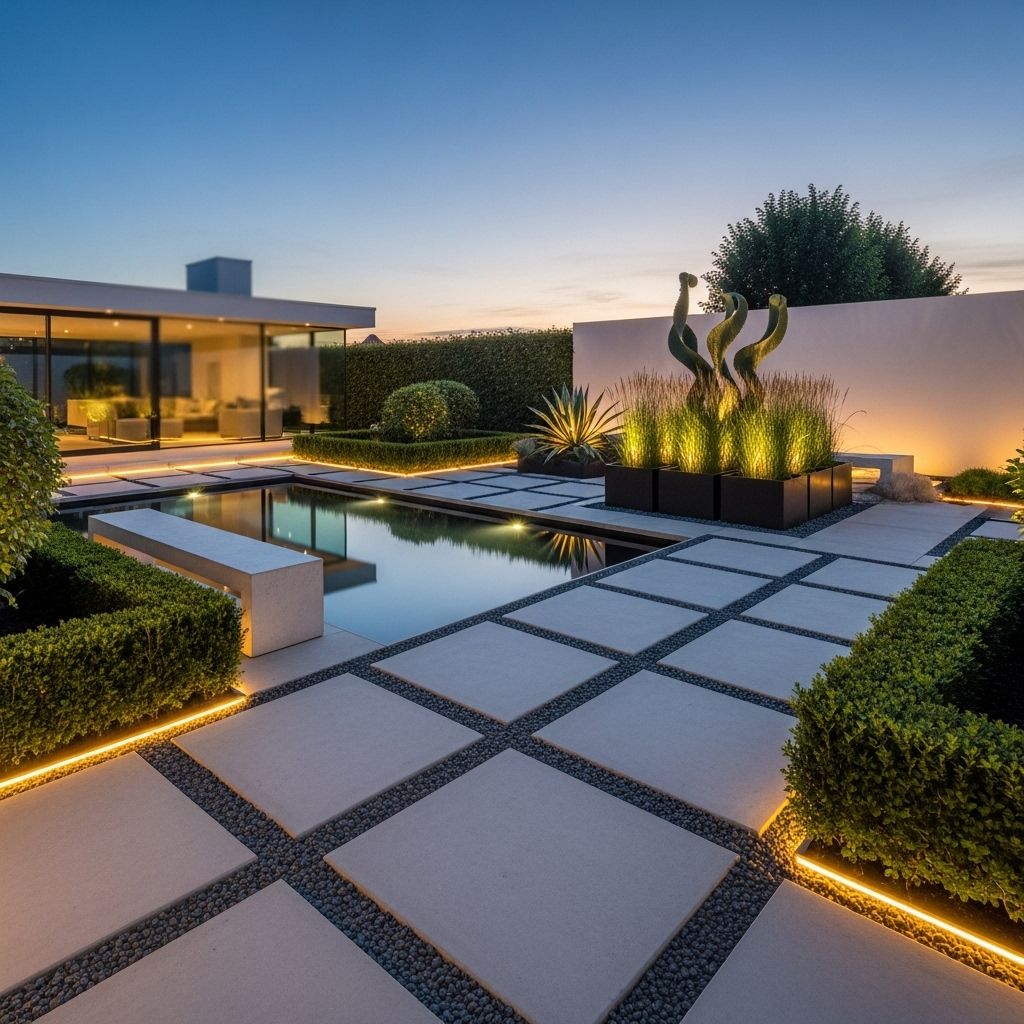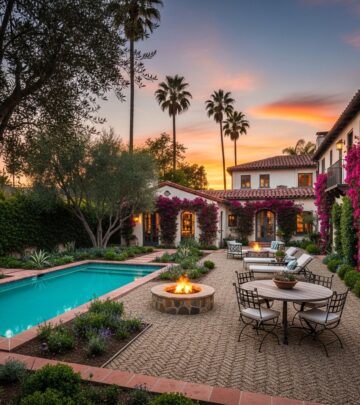Modernist Garden Design Ideas: 10 Timeless Outdoor Concepts
Transform your outdoor space with timeless principles from mid-century landscape architecture

Image: HearthJunction Design Team
The modernist movement of the past century fundamentally changed how we think about outdoor spaces. These forward-thinking designers weren’t just creating gardens; they were reimagining how people interact with nature. Modernists believed better gardens meant better living, introducing the revolutionary concept of gardens as extensions of living space rather than merely decorative or functional plots.
During the post-war suburban boom, modernist landscape architects transformed even modest yards into livable outdoor rooms. Their approach simplified maintenance while maximizing enjoyment, using clean lines, thoughtful hardscaping, and strategic planting to create spaces that invited exploration and relaxation. Even decades later, contemporary garden design continues to draw inspiration from these pioneering principles.
Let’s explore ten timeless ideas from modernist garden design that you can incorporate into your own outdoor space, regardless of its size or your gardening experience.
Restrained Plant Palettes
Thomas Church, the innovative landscape architect who gave us the kidney-shaped swimming pool, championed simplicity in planting schemes. He recognized that limiting plant varieties created visual harmony while dramatically reducing maintenance demands.
By selecting a focused palette of plants that work well together, you create a more cohesive look while avoiding the overwhelm of managing dozens of different species with varying needs. Start with a strong foundational design using just a handful of plant varieties that thrive in your climate, then add more diversity later if desired.
This approach allows you to become familiar with the specific needs of fewer plants, making care more manageable. It also creates a more visually restful space where the eye can appreciate the subtle variations in texture and form without being overwhelmed by too many competing elements.
Sculptural Plant Specimens
Modernists rejected the Victorian-era fixation on high-maintenance flower beds that required constant attention. Instead, they embraced the drama of well-placed sculptural plants that create year-round interest without demanding weekly maintenance.
This principle works exceptionally well in gravel courtyards or minimalist spaces where a single striking plant—like an architectural agave, a graceful Japanese maple, or a statuesque palm—can serve as a living sculpture. The natural tones of crushed stone or simple hardscaping provide the perfect neutral backdrop to showcase the plant’s form and foliage.
Consider plants with distinctive silhouettes, interesting branching patterns, or remarkable textural qualities. Place them where they can be appreciated from multiple viewpoints, including from inside your home.
Clean Lines and Sharp Angles
Modernist gardens are immediately recognizable by their crisp edges and geometric precision. Unlike the flowing, naturalistic curves of English cottage gardens, modernist landscapes embrace architecture-inspired forms that create clear spatial definition.
Incorporate this principle by using straight-edged raised beds, rectangular planting areas, or angular pathways. The juxtaposition of these strong geometric forms against the organic shapes of plants creates a pleasing visual tension that highlights both elements.
This approach also makes maintenance more straightforward—straight lines are easier to edge, mow around, and keep looking tidy than elaborate curves and complicated shapes.
Hardscaping as the Primary Framework
In modernist garden design, the structural elements often take precedence over plantings. Thoughtfully designed hardscaping—patios, paths, walls, and steps—creates the architectural framework that organizes the entire space.
As architectural photographer Pierluigi Serraino notes, “The hardscape is really profoundly consequential” in modernist landscapes. While plants provide beauty and connection to nature, it’s the hardscaping that defines how people move through and use the space.
Consider investing in quality hardscape materials that complement your home’s architecture. Clean concrete, natural stone, or wood decking can all provide the strong lines and durability that form the backbone of a modernist garden.
Designed for Living
Perhaps the most revolutionary aspect of modernist garden design was the emphasis on creating outdoor spaces specifically for human enjoyment and activity. These weren’t just gardens to look at—they were extensions of the home meant to be fully inhabited.
Modernist gardens typically include comfortable seating areas, dining spaces, cooking facilities, and recreation zones. The layout considers how people naturally move and gather, with attention to practical concerns like shade, wind protection, and proximity to indoor spaces.
When planning your garden, think beyond aesthetics to consider how you actually want to use the space. Create “rooms” for different activities, considering sight lines, privacy, and the relationship between indoor and outdoor areas.
Blurring Indoor-Outdoor Boundaries
Modernist architects and landscape designers worked together to dissolve the traditional separation between inside and outside. Large windows, sliding glass doors, and consistent flooring materials that extend from interior to exterior spaces create a seamless transition.
You can apply this principle even without architectural renovations. Position key garden elements where they can be viewed from inside the home, use materials that complement your interior finishes, and consider the garden as a visual extension of your living space.
This approach maximizes the impact of your garden by making it part of your daily experience, even when you’re indoors.
Creating Defined Zones
Rather than treating the garden as a single open space, modernist designers often divided outdoor areas into distinct functional zones. This approach makes even modest gardens feel larger and more purposeful.
Consider dividing your garden into areas for dining, lounging, play, or contemplation. These zones can be defined through changes in materials, slight level changes, decorative screens, or strategic planting.
Designer Barbara Samitier demonstrates this principle in her London garden by using “layers and big blocks of soft, textural planting” to break up the space and “create a sense of intrigue.” This zoning approach turns a simple walk through the garden into an experiential journey.
Crafting a Journey
Modernist gardens often incorporate pathways that guide visitors on a curated experience through the space. Even in a small garden, a thoughtfully designed path can create a sense of discovery and make the area feel larger.
Designer Stefano Marinaz exemplifies this approach in a 10m x 10m city garden, transforming a plain square of grass with “a winding path that takes visitors on an immersive journey through rich and textural planting.” The curved pathway creates a sense of mystery and reveals different views as you move through the space.
Consider how paths can create rhythm and pacing in your garden, perhaps narrowing to slow movement in areas meant for contemplation or widening to encourage gathering in social zones.
Strategic Privacy Solutions
Modernist designers recognized the importance of creating privacy without sacrificing style or light. Rather than erecting tall fences or planting dense hedges around the entire perimeter, they used targeted screening only where needed.
In contemporary adaptations of this approach, designer George Cullis uses “a deep vegetative layer at the far end of the garden” to screen neighboring buildings, while “subtle panels of slatted trellis and two stunning multi-stem Amelanchier lemarkii trees create privacy around a generous dining terrace.”
Consider using a mix of architectural elements and strategic plantings to block unwanted views while maintaining an open, airy feel in the rest of the garden.
Embracing Borrowed Landscape
Modernist designers were masters at incorporating existing features beyond the property line—distant mountains, neighboring trees, or urban skylines—into their garden compositions. This technique, known as “borrowed landscape,” makes gardens feel more expansive and connected to their surroundings.
Designers Lucie Conochie and Jane Heather demonstrate this principle in a city courtyard where “neighboring trees blend with an arrangement of shrubs and architectural plants” to create a cohesive scene that extends beyond the property boundaries.
Look for opportunities to frame appealing views outside your garden while screening unattractive elements. Strategic placement of trees and shrubs can direct the eye toward distant features that complement your design.
Frequently Asked Questions
Q: Do modernist garden principles only work for large spaces?
A: Not at all. Many modernist design ideas actually work exceptionally well in small spaces. Clean lines, restrained planting palettes, and thoughtful zoning can make compact gardens feel more spacious and functional. The examples from the Society of Garden Designers awards show how modernist principles can transform even tiny urban gardens.
Q: Are modernist gardens expensive to create?
A: While high-quality hardscaping can represent a significant investment, many modernist principles actually reduce costs compared to traditional garden styles. Using fewer plant varieties in larger groupings is often more economical than complex mixed plantings. Similarly, replacing high-maintenance lawns with gravel, decking, or simple paving can reduce both installation and long-term maintenance costs.
Q: Do modernist gardens lack color and interest?
A: While modernist gardens often emphasize form and texture over flower color, they certainly don’t have to be monochromatic or sterile. Many successful modernist-inspired gardens incorporate seasonal color through carefully chosen flowering plants or colorful foliage. The key is using color purposefully rather than randomly, often in bold blocks rather than scattered throughout the space.
Q: Can I incorporate modernist elements into an existing traditional garden?
A: Absolutely. Many gardens successfully blend design approaches. Consider adding a modernist-inspired seating area with clean lines and simple materials within your existing garden, or renovating one section of your garden using modernist principles while maintaining traditional elements elsewhere. The clarity and simplicity of modernist design often works well as a counterpoint to more naturalistic or ornate garden styles.
References
- https://www.gardenista.com/posts/10-garden-ideas-steal-modernists/
- https://www.gardenista.com/tag/modern/
- https://www.gardenista.com/posts/required-reading-modern-garden-pierluigi-serraino/
- https://www.gardenista.com/tag/garden-design/
- https://www.gardenista.com/posts/small-city-garden-ideas-sgd-awards-2025/
Read full bio of Anjali Sayee












